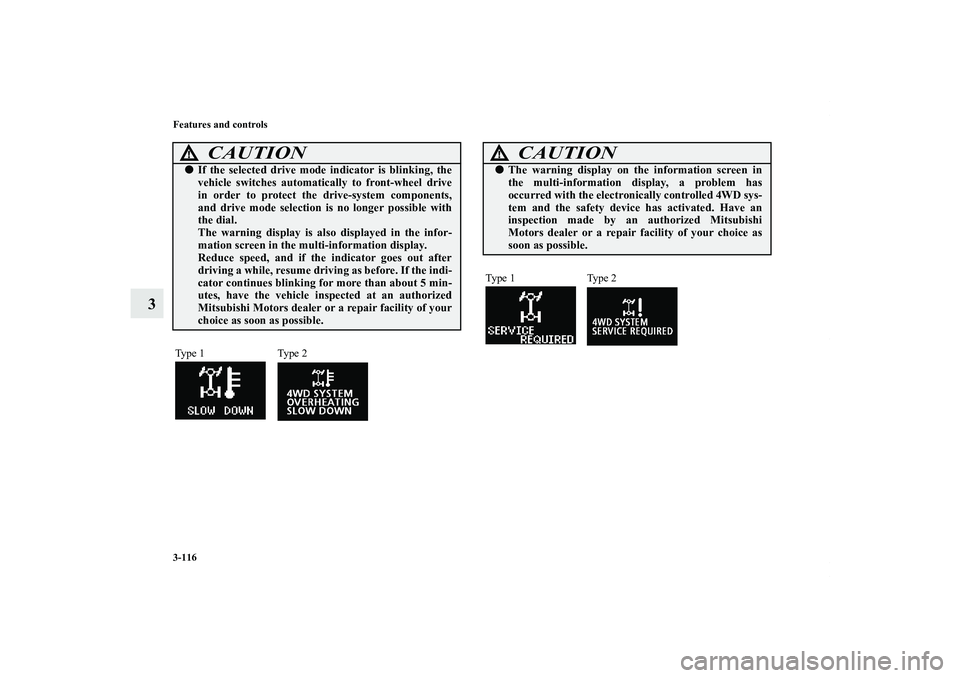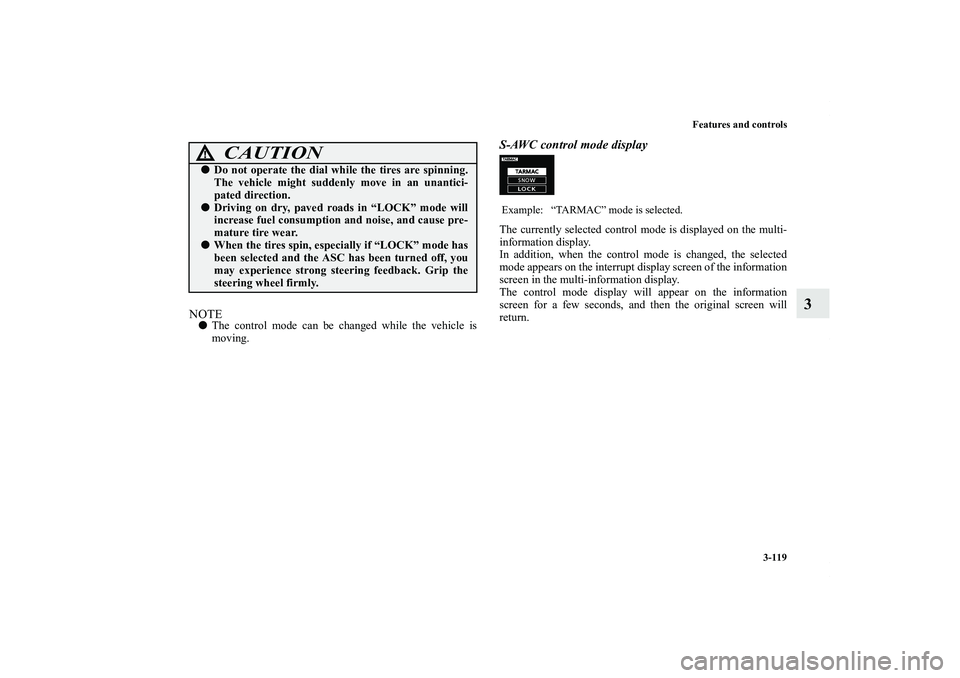Page 228 of 714

Features and controls
3-113
3
Passing accelerationTo gain extra acceleration in “D” (DRIVE) position (when
passing another vehicle) push the accelerator to the floor. The
CVT will automatically downshift.NOTE�In sports mode, downshifts do not take place when the
accelerator is depressed all the way to the floor.WaitingFor short waiting periods, such as at traffic lights, the vehicle
can be left in selector lever position and held stationary with
the service brake.
For longer waiting periods with the engine running, place the
selector lever in the “N” (NEUTRAL) position and apply the
parking brake, while holding the vehicle stationary with the
service brake.
Prior to moving off after having stopped the vehicle, make sure
that the selector lever is in “D” (DRIVE) position or Sports
mode position.
ParkingTo park the vehicle, first bring it to a complete stop, fully
engage the parking brake, and then move the selector lever to
the “P” (PARK) position.When the CVT makes no speed changeIf the CVT does not shift while driving, or your vehicle does
not pick up enough speed when starting on an uphill slope, it
may be that there is something unusual happening in the trans-
mission, causing a safety device to activate. Have your vehicle
checked at an authorized Mitsubishi Motors dealer or a repair
facility of your choice as soon as possible.NOTE�When the warning display and “SLOW DOWN” or the
warning display and “SERVICE REQUIRED” appear
on the information screen in the multi-information dis-
play, there could be a malfunction in the CVT. Refer to
“Continuously variable transmission (CVT): Warning dis-
play” on page 3-108.
CAUTION
!�To avoid transmission overheating, never try to keep
your vehicle stationary on a hill by using the acceler-
ator pedal. Always apply the parking brake and/or
service brake.�Do not rev the engine unnecessarily while the vehicle
is stationary. Unexpected acceleration may occur if
the selector lever is in a position other than “P”
(PARK) or “N” (NEUTRAL).
BK0138000US.book 113 ページ 2011年4月13日 水曜日 午前11時17分
Page 229 of 714

3-114 Features and controls
3Electronically controlled 4WD system
(if so
equipped)N00517200142
The electronically controlled 4WD system is an all-wheel drive
system that allows one of three drive modes to be selected with
a switch, in accordance with the driving conditions.
The following drive modes are available.
4-wheel drive operation requires special driving skills.
Carefully read the “4-wheel drive operation” section on page 3-
122 and take care to drive safely.
Drive mode-selectorThe drive mode can be switched by turning the dial while the
ignition switch is in the “ON” position.
The drive mode is displayed as an interrupt display on the
information screen in the multi-information display when the
drive mode is switched.
After a few seconds, the information screen returns from the
drive mode display to the previous screen.
Drive mode
Function
2WDThis mode is for economical
driving on normal dry roads
and freeways.
Driving in front-wheel drive.
4WD AUTOThe default mode.
This mode is for automatically
controlling the distribution of
driving torque to all four
wheels according to the driving
conditions.
4WD LOCKThis mode is for driving in slip-
pery conditions such as on
snow-covered roads or sand.
The large amount of driving
torque that is applied to the rear
tires enables getting out of slip-
pery areas and powerful driving
is possible across all ranges.
1- 2WD
2- 4WD AUTO
3- 4WD LOCK
BK0138000US.book 114 ページ 2011年4月13日 水曜日 午前11時17分
Page 230 of 714
Features and controls
3-115
3
NOTE�The drive mode can be switched while driving or stopped.Drive mode indicatorNormally the indicator illuminates when the ignition switch is
turned to the “ON” position, and then the drive mode is dis-
played a few seconds after the engine is started.
The status of each drive mode display is as follows.
Drive mode
Display
Ty p e 1
Ty p e 2
2WD
4WD AUTO
4WD LOCKCAUTION
!�Do not operate the drive mode-selector with the
front wheels spinning on a snowy road or in similar
conditions. The vehicle could lunge in an unexpected
direction. �Driving on dry, paved roads in “4WD LOCK” mode
causes increased fuel consumption, noise, and pre-
mature tire wear.�Do not drive with the tires spinning in “2WD” mode.
Doing so could generate heat in the drive-system
components.
Type 1 Type 2
Drive
Mode
Drive mode
indicator
“4WD” indicator
“LOCK” indicator
2WD OFF OFF
4WD AUTO ON OFF
4WD LOCK ON ON
BK0138000US.book 115 ページ 2011年4月13日 水曜日 午前11時17分
Page 231 of 714

3-116 Features and controls
3
CAUTION
!�If the selected drive mode indicator is blinking, the
vehicle switches automatically to front-wheel drive
in order to protect the drive-system components,
and drive mode selection is no longer possible with
the dial.
The warning display is also displayed in the infor-
mation screen in the multi-information display.
Reduce speed, and if the indicator goes out after
driving a while, resume driving as before. If the indi-
cator continues blinking for more than about 5 min-
utes, have the vehicle inspected at an authorized
Mitsubishi Motors dealer or a repair facility of your
choice as soon as possible.Type 1 Type 2
CAUTION
!�The warning display on the information screen in
the multi-information display, a problem has
occurred with the electronically controlled 4WD sys-
tem and the safety device has activated. Have an
inspection made by an authorized Mitsubishi
Motors dealer or a repair facility of your choice as
soon as possible.Ty p e 1 Ty p e 2
BK0138000US.book 116 ページ 2011年4月13日 水曜日 午前11時17分
Page 234 of 714

Features and controls
3-119
3
NOTE�The control mode can be changed while the vehicle is
moving.
S-AWC control mode displayThe currently selected control mode is displayed on the multi-
information display.
In addition, when the control mode is changed, the selected
mode appears on the interrupt display screen of the information
screen in the multi-information display.
The control mode display will appear on the information
screen for a few seconds, and then the original screen will
return.
CAUTION
!�Do not operate the dial while the tires are spinning.
The vehicle might suddenly move in an unantici-
pated direction.�Driving on dry, paved roads in “LOCK” mode will
increase fuel consumption and noise, and cause pre-
mature tire wear.�When the tires spin, especially if “LOCK” mode has
been selected and the ASC has been turned off, you
may experience strong steering feedback. Grip the
steering wheel firmly.
Example: “TARMAC” mode is selected.
BK0138000US.book 119 ページ 2011年4月13日 水曜日 午前11時17分
Page 235 of 714

3-120 Features and controls
3
S-AWC operation display
N00542500022
The S-AWC operation status can be displayed on the informa-
tion screen in the multi-information display.
To display the status, press the multi-information meter switch
to change the information screen.
Refer to “Information screen (With ignition switch in the “ON”
position)” on page 3-173.
CAUTION
!�When the S-AWC control mode display blinks and
“SLOW DOWN” is displayed on the information
screen in the multi-information display, the S-AWC
has been temporarily suspended to prevent over-
heating.
At that time, the drive system of your vehicle is auto-
matically switched to front wheel drive from all
wheel drive. Reduce your speed to cool down the S-
AW C .
After driving for a while, if the S-AWC control
modes display stops blinking and the “SLOW
DOWN” on the information screen in the multi-
information display disappears, the drive system of
your vehicle will return to the all wheel drive.
If the S-AWC control mode display continues blink-
ing for more than about 5 minutes, have the vehicle
inspected at an authorized Mitsubishi Motors dealer
or a repair facility of your choice.
BK0138000US.book 120 ページ 2011年4月13日 水曜日 午前11時17分
Page 236 of 714

Features and controls
3-121
3
Display exampleThe S-AWC operation status is displayed.
S-AWC warning display
N00542600036
When there is a malfunction in the system, the warning dis-
play will appear on the information screen in the multi-infor-
mation display.
In addition, the S-AWC control mode display in section (A)
will go out at the same time.
After that, the “4WD” display in section (A) will blink.
Right-left torque control display
The status of control over driving torque to the right and left front
wheels will be displayed as a bar graph.
A, D- The status of control over clockwise turning
B, C- The status of control over counterclockwise turning
Front-rear torque control display
The status of control over driving torque to the front and rear
wheels will be displayed in section (E) of the meter as a bar
graph.
WA R N I N G
!�Always concentrate on your driving first. Keep your
eyes and mind on the road. Distractions while driv-
ing can lead to an accident.
BK0138000US.book 121 ページ 2011年4月13日 水曜日 午前11時17分
Page 237 of 714

3-122 Features and controls
34-wheel drive operation
N00530600143
Your vehicle has been designed primarily for use on pavement.
But its unique 4 -wheel drive system allows you to occasion-
ally travel on unpaved roads, to campgrounds, picnic sites, and
similar locations.
Not only does this ensure better handling on dry, paved roads
but also permits better traction when driving on slippery, wet or
snow-covered roads and when moving out of mud.
But it is not suitable for heavy off road use or towing in rough
conditions.
It is particularly important to note that 4-wheel drive may not
give sufficient hill climbing ability and engine braking on steep
slopes. You should try to avoid driving on steep slopes.
Also, you must exercise caution when driving on sand and mud
and when driving through water because sufficient traction
may not be available in certain circumstances.
Please avoid driving the vehicle through areas where the tires
may get stuck in deep sand or mud.
CAUTION
!�The system may be malfunctioning.
Park your vehicle in a safe place and stop the engine.
Restart the engine and check whether the warn-
ing display goes out.
If the warning display and “SERVICE
REQUIRED” go out, there is no abnormal condi-
tion. If the warning display does not go out or
appears frequently, it is not necessary to stop the
vehicle immediately, but we recommend that you
have your vehicle inspected.
BK0138000US.book 122 ページ 2011年4月13日 水曜日 午前11時17分